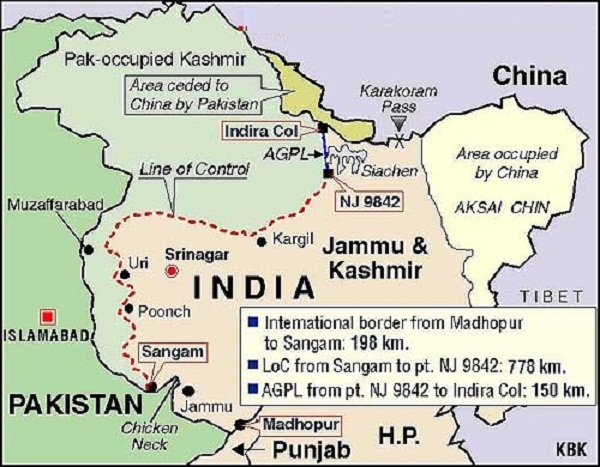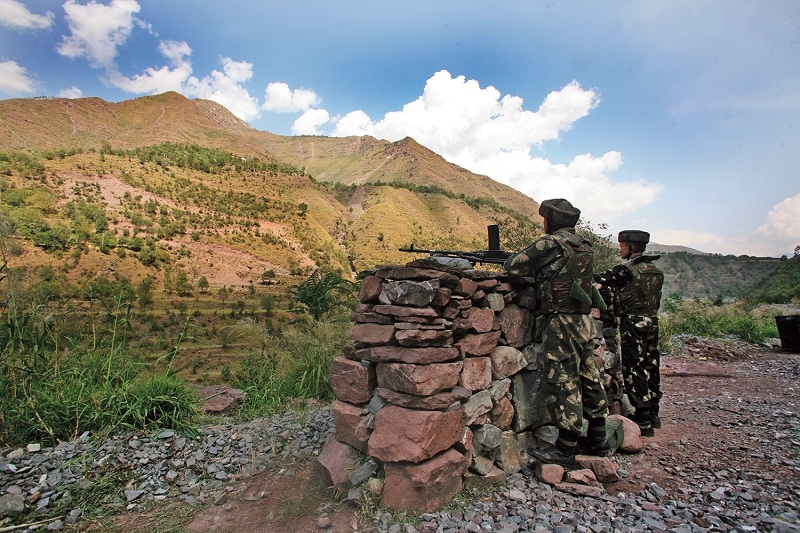POK on India’s radar? Why not?- II

India’s recent war diary: After the end of Moghul Rule in India the state of Jammu and Kashmir remained in the hands of Afghan, Sikh, and the Dogra Rulers. The last Dogra ruler was Maharaja Hari Singh who accepted accession to the Indian Union in 1947. Afghan Rule was from 1752 to 1819, Sikh Rule was from 1819 to 1846, and the Dogras ruled the State from 1846 to 1949. Following are the important events and landmarks during the Dogra rule:
a) Srinagar was only the summer capital, Jammu was the capital.
b) The frontier region of Ladakh was under the charge of Thanedars famous among whomwere Magna, Mehta Bastiram, Mehta Mangal.
c) Baltistan was under another Thanedar, main town being Askardu.
d) Later, both Ladakh and Baltistan were combined and put under the charge of an Administrator with Leh as headquarters.
e) Gilgit was made a separate administrative Unit, it’s headquarter was a new town called Gilgit. It lasted till 1949.
Pak-sponsored invasion: Immediately after India and Pakistan acquired independent Dominion status in the British colony, Afghan tribesmen and Paikistan’s regular Army invaded the North-West Kashmir to conquer the Princely State. War on a limited scale broke out.
However, in July 1949, a ceasefire was declared and the ceasefire line was defined as the Line of Control (LoC) which divided both India and Pakistan as well as Kashmir In 1952, the Monarchy was abolished.
In April 1951, Dr. Karan Singh, who was the Sadar-i-Riyasat issued a proclamation of constituting a Constituent Assembly to frame the Constitution of Jammu and Kashmir. In November 1956 the Constitution was ratified and became enforceable on 26th January 1957.
China invaded Ladakh and the then NEFA now Arunachal Pradesh in 1962. Indo-Pak wars took place in 1965 (which ended with Tashkent Agreement in 1966), and in 1971 which created Bangladesh, and ended with the Shimla Agreement in 1972.
The period between 1752 and 1949 is a history tumultuous and full of skirmishes and large scale wars among the British imperial power, Afghans, Sikhs and Dogras. The Chinese Emperor and the Russian Czar too had their pound of flesh.
Constitution of Jammu and Kashmir:
The Constitution of J & K is divided in 12 Parts, 158 Articles and 7 Schedules.
Preamble:-WE, THE PEOPLE OF THE STATE OF JAMMU AND KASHMIR, having solemnly resolved, in pursuance of the accession of this State to India which took place on the twenty sixth day of October, 1947;
To further define the existing relationship of the State with the Union of India as an integral part thereof, and to secure to ourselves,
JUSTICE, social, economic and political; LIBERTY of thought, expression, belief, faith and' worship; EQUALITY of status and of opportunity; and to promote among us all;
FRATERNITY assuring the dignity of the individual and the unity of the Nation;
IN OUR CONSTITUENT ASSEMBLY this seventeenth day of November, 1956, do HEREBY ADOPT, ENACT AND GIVE TO OURSELVES THIS CONSTITUTION.
PART I: PRELIMINARY.
1. Short title and commencement:-
(1) This Constitution may be called the Constitution of Jammu and Kashmir.
(2) This section and sections 2, 3, 4, 5, 6, 7, 8, and 158 shall come into force at once and the remaining provisions of this Constitution shall come in to force on the twenty-sixth day of January, 1957, which day is referred to in this Constitution as the commencement of this Constitution. The Preamble which elucidates highest human values caring for human dignity , seems to contradict its own text and spirit which is explicitly pronounced through its Articles treating the Kashmiri citizens as superior class I individuals over the other Indian citizens.
The ancient Hindu traits discovered in the region: The names or titles which were given by the Muslim rulers, abandoning the original were as following: (i) Achabal was earlier known as Aksipalanaga; ii) Islamabad was Anatnag, (iii) Andakot was earlier Jayapidapore, (iv) Pulwama district was earlier Avantipora, (v) Baramulla district was earlier Bandipore, (vi) Baramulla was established by King Bhimsen in 2306 BC. This meant eruption of volcanoes 12 times, (vii) Bijbehara was earlier Vijay Para, (viii) Boniyar was founded by Pandavas, (ix) Budgam was earlier Barha Gaon (x) Beerwah village was earlier Behroop, (also it was named after Raja Beerwa, (xi) Burzahom or Burzahama (Present Shrinagar) was established around 2500 BC which was famous since then for colorful pottery,(xii) Shahabad was earlier known as Doru, (xiii ) Gufkral in Pulwama district a place known for sheep and goats dates its origin 2470 BC,(xiv) Gurez was earlier known as ‘go-harai’ i.e. cow pasture which dates back to 1st century AD and where hundreds of stone inscriptions in Kharosthi, Brahmi, Hebrew and Tibetian were found, (xv) Dawar, an Archeological site along the river Kishen Ganga—the seat of Sharada University, this area was also called as Rajatarangini, (xvi) Kashmir itself was earlier known as Kashyap, the grandson of Lord Brahma, (xvii) Ludov one of the oldest temples, dates back at 7th century AD, an Rudresh temple, (xviii) Butsher was earlier known as Buteshwar, and ruins of settlement called ar-nag which was at the hills of Shankaracharya Temple, Nar-Nag also was a pilgrimage for Hindus where Rishi Vashisth’s ashram was situated , the architecture of the Temple was influenced by the Greeks. (xxiv) Emperor Ashok started building Temples in this complex and the first Temple was Jyeshthesa temple of Lalitaditya at 725-753 AD, (xxv) Nil-Nag is a holy lake for Hindus, (xxvi) Pandrethan was a capital city of Kashmir built around 921 AD, by King Parth,(xxvii) Sopore was earlier called Surpura, King Avanti Varman’s Minister Sura dating back at 855-883 AD,(xxviii) Sut Haran was earlier known as ‘Sita Haran’, (xxix) Wular lake earlier was known as Mahapadma-Saras.
History of Pakistan Occupied Kashmir (POK): At the time of the Independence in 1947, the British abandoned their claim over the Princely States and allowed them to take decision on the options of joining either India or Pakistan or remain independent. Maharaja Hari Singh, chose to remain independent dominion state.

In 1947, an uprising against the Maharaja Hari Singh had broken out in Poonch. The reason behind this uprising was punitive taxes by the Hari Singh on the peasantry in the region.
On 21 October 1947, several thousand Pashtun tribesmen from the North-West Frontier Province (NWFP) supported by the Pakistan army infiltrated into Jammu and Kashmir in order to liberate it from the Maharaja's rule.
Soldiers of Maharaj tried to avert this invasion but the pro-Pakistan rebellions were armed with modern armaments and gained control of almost the entire Poonch district on 24 October 1947.
The invaders captured the towns of Muzaffarabad and Baramulla and reached near twenty miles northwest of the State's capital Srinagar.
On 24 October 1947, the Maharaja requested for the military assistance of India, which provided the assistance on the condition that Maharaja Hari Singh would sign an “Instrument of Accession”.
Maharaja Hari Singh singed the “Instrument of Accession” and handed over three subjects i.e. control of defence, external affairs and communications to the Government of India.
Indian troops were immediately airlifted into Srinagar while Pakistan intervened subsequently and war started between the Indian and Pakistani armies with the two areas of control stabilized and the regions won by the Pakistan supported rebellions remained with Pakistan which is now called Pakistan Occupied Kashmir (POK).
The POK is administratively divided into two parts, which are called Jammu and Kashmir and Gilgit-Baltistan in official languages. 'Azad Jammu and Kashmir' is also known as the Azad Kashmir in Pakistan. Azad Kashmir (AJK) is governed under the Azad Kashmir Interim Constitution Act, 1974.
Azad Kashmir (AJK) has a President, a Prime Minister, and a council but the governing structure is totally powerless and works under the Pakistan government.
Districts in the POK: In the southern part of Pakistan-occupied Kashmir, there are 8 districts: Neelam, Mirpur, Bhimbar, Kotli, Muzaffarabad, Bagh, Rawalakot and Sudhanoti.
These accessions of the Princely States in India viz, Kashmir, and Junagadh created many constitutional issues which had several political problems in the new India that raised international repercussions. (To be continued…)
